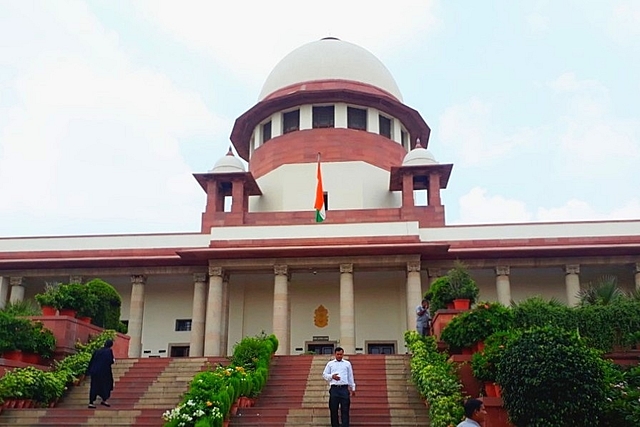
SC Is Over-Reaching On Rafale: It Is Now Party To The Weakening Of Institutions
If the Modi government has any self-respect, it should tell the court it cannot divulge details of the Rafale deal in a “sealed cover”.
The next time the Indian Army chief is asked to fight a war, maybe he should consider placing his battle plans in a “sealed cover” before the Chief Justice of India (CJI) so that the country achieves true transparency before it can legitimately defend itself. After all, what’s better than transparency in a democracy adjudicated by men (almost always men) in black robes?
If you think this statement is rather outlandish, this is the logical end-outcome of the Supreme Court demanding to know the price of a Rafale combat aircraft. In hearings yesterday (31 October), a bench comprising Chief Justice Ranjan Gogoi, and justices U U Lalit and K M Joseph, said “the court would like to be apprised of the details with regard to the pricing/cost, particularly the advantage thereof, if any, which again will be submitted to the court in a sealed cover.”
We will come back to the farcical nature of contents delivered in “sealed covers” later, but let’s first look at how the court has inserted itself into a technical decision regarding which aircraft the country should buy for its defence, how much it should pay for the same, and whether the price paid is worth it.
Earlier, on 10 October, the bench had merely wanted to know how the government decided on its Rafale deal with Dassault, and the government duly complied by giving it a statement on the decision-making process in a “sealed cover” on 26 October. Now, the court not only wants to know how the deal was decided, but whether the decision itself was right.
How is it the job of the judiciary to decide this issue? Is it even equipped to do so? Let’s say the government tomorrow gives it another sealed envelope indicating that the price being paid for each Rafale is “x”, and then offers a paragraph each on the advantages of each weapon system, radar, or device attached to the combat aircraft. What, one may ask, is the court’s competence to decide on any of this?
Zero.
And if it is zero, it follows that if at all the court wants to figure out whether the price was right, the weapon systems were right, and that the difference in prices paid for a fully-loaded Rafale and the deal being negotiated earlier was justified, will it not need another expert panel to advise it on the matter before it takes a view? Or will it ask Rahul Gandhi, Arun Shourie and Yashwant Sinha to help it decide whether the deal was kosher?
And once experts are going to be consulted, where is the question of secrecy in a defence deal with huge implications for security?
Why then it is so outlandish for me to suggest that even war plans can be given to the court in a sealed envelope?
The farce involved in giving information in a sealed envelope should be obvious to anyone who can think beyond basics. Sealed covers are not meant to remain sealed; at the very least, the CJI will have to open it. Will he then take one look and decide for himself if the answers given are valid or not, especially when the subject is technical? Will he discuss it with his spouse, or fellow-judges before arriving at a decision? Is secrecy compromised once so many people are involved in discussing it? And what will the CJI do with the contents once they are out? Will he read and destroy? How is the government to know that these secret details are indeed destroyed to be sure that they don’t fall in the wrong hands?
Will the CJI file an affidavit to himself that all secret contents are destroyed, and that he personally supervised it?
The opposition, knowing the government is in a spot, is cheering the judiciary on and giving it covering fire in this blatant effort to dismantle the constitutional separation of powers between elected governments and the judiciary. There is a chorus that the government is “destroying” institutions, as if this judicial encroachment is itself not an attempt to circumscribe and debase the institution of the executive and the legislature. The executive is as much a creature, and “basic feature”, of the Constitution as the judiciary, and the Supreme Court should respect this separation of powers and not try to run the country – or its defence – through judicial orders.
When the Supreme Court can, one day, seek merely to know the process of decision-making on Rafale, and a few days later decide that it wants to know even more details that have implications for defence secrecy, what kind of credibility can it have? A court with a mind that is changeable and ever-demanding of compliance from the executive is as much as party to the destruction of institutions as the executive it seeks to rein in.
And one may well ask what happened to the names of eight allegedly corrupt former CJIs that were given to the Supreme Court in 2010 by Shanti Bhushan, the father of the compulsive PIL-ster now using the judiciary to demand more secret disclosures in sealed covers.
We are heading towards kritarchy, or rule by the judiciary, and this is an even bigger threat to democracy than mere authoritarian leaders. The latter are elected, and hence can be rejected by the electorate, but the judiciary is accountable to no one but itself. It should refrain from making laws and demanding compliance in areas that are not meant to be decided by judges.
If the Narendra Modi government has any self-respect, it should tell the court it cannot divulge these details. Let the court do what it will. What will it do? Send the P and the Defence Minister to jail?